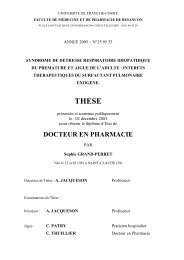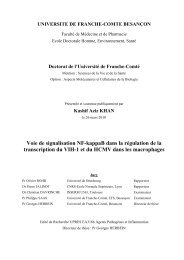THÈSE - Université de Franche-Comté
THÈSE - Université de Franche-Comté
THÈSE - Université de Franche-Comté
Create successful ePaper yourself
Turn your PDF publications into a flip-book with our unique Google optimized e-Paper software.
SYNTHESIS AND IMPLICATIONS FOR CONTROL OF A. TERRESTRIS POPULATIONS<br />
The present study <strong>de</strong>monstrated a bottom-up regulation of the dynamics of vole populations<br />
on a parcel scale. It suggests a strong relationship between the growth and the abundance of A.<br />
terrestris populations and their optimal habitat, whose characteristics can be modified by<br />
certain farming practices and grassland management.<br />
Our study showed that more intensive grassland management was favourable to A. terrestris<br />
populations. This may be explained by the fact that grassland management may indirectly<br />
favour T. europaea populations and provi<strong>de</strong> better shelter against predators (Jacob & Brown<br />
2000) and thermal variations (Jacob & Halle 2001). In contrast, practices like harrowing,<br />
ploughing and grazing are unfavourable as they disturb soil burrows and vegetation cover.<br />
However, as <strong>de</strong>scribed by Jacob & Halle (2001), we found that each of these favourable and<br />
unfavourable practices must be sufficiently intensive and repeated (frequent mowing and soil<br />
work, intensive grazing) to have a long-term effect on vole populations.<br />
However, we can not exclu<strong>de</strong> that other variables could also affect the A. terrestris population<br />
increase on a parcel scale. These variables could inclu<strong>de</strong> soil and vegetation characteristics,<br />
the landscape context and the farming management in adjacent areas. In<strong>de</strong>ed, theoretical<br />
approaches have shown that dispersal alone conditional on the properties of local population<br />
dynamics can explain <strong>de</strong>nsity variations in lattice mo<strong>de</strong>ls (Ranta 1998). The role of predation<br />
may also account for inter-annual variations of small mammal population <strong>de</strong>nsity (Hanski et<br />
al. 2001). Thus, on a larger scale, the role of arrangement of habitats and farming practices in<br />
population dynamic control subsidiary or complementary to predation and parasitism (Newey<br />
et al. 2005) cannot be discar<strong>de</strong>d.<br />
The interpretation of our results and their subsequent application in a control strategy will<br />
have to consi<strong>de</strong>r (i) the phase of the population cycle (Edge et al. 1995), (ii) the spatial scale at<br />
which control is to be carried out, (iii) the intensity and the duration of the disturbing farming<br />
practices (Jacob 2003), (iv) the farming practice history in the area un<strong>de</strong>r study.<br />
Chemical ro<strong>de</strong>ntici<strong>de</strong>s currently used to prevent extensive crop damage are also hazards to<br />
non-target animals and auxiliary fauna (foxes, buzzard, etc…) (Brakes & Smith 2005). They<br />
Thèse C. Morilhat 2005 109









